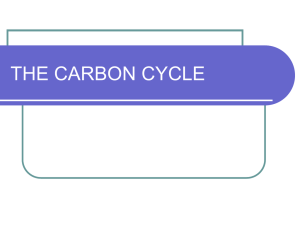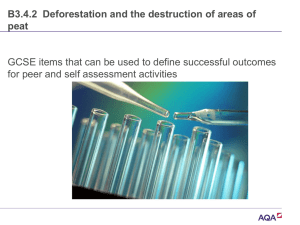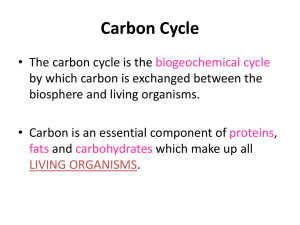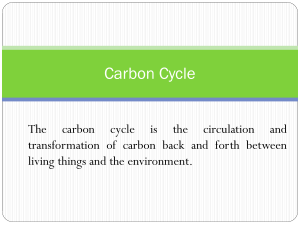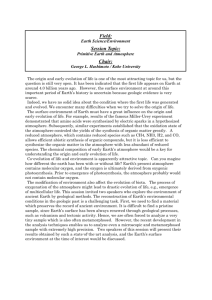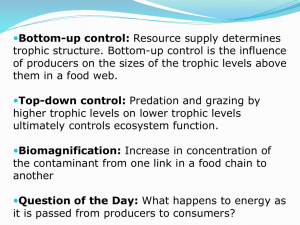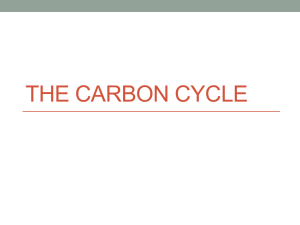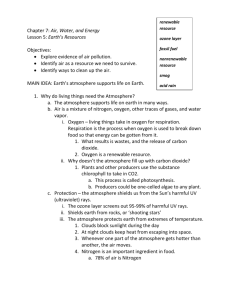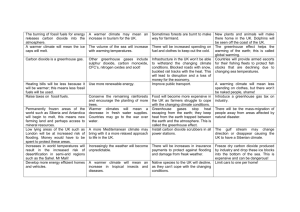The Carbon Cycle Role Play
advertisement
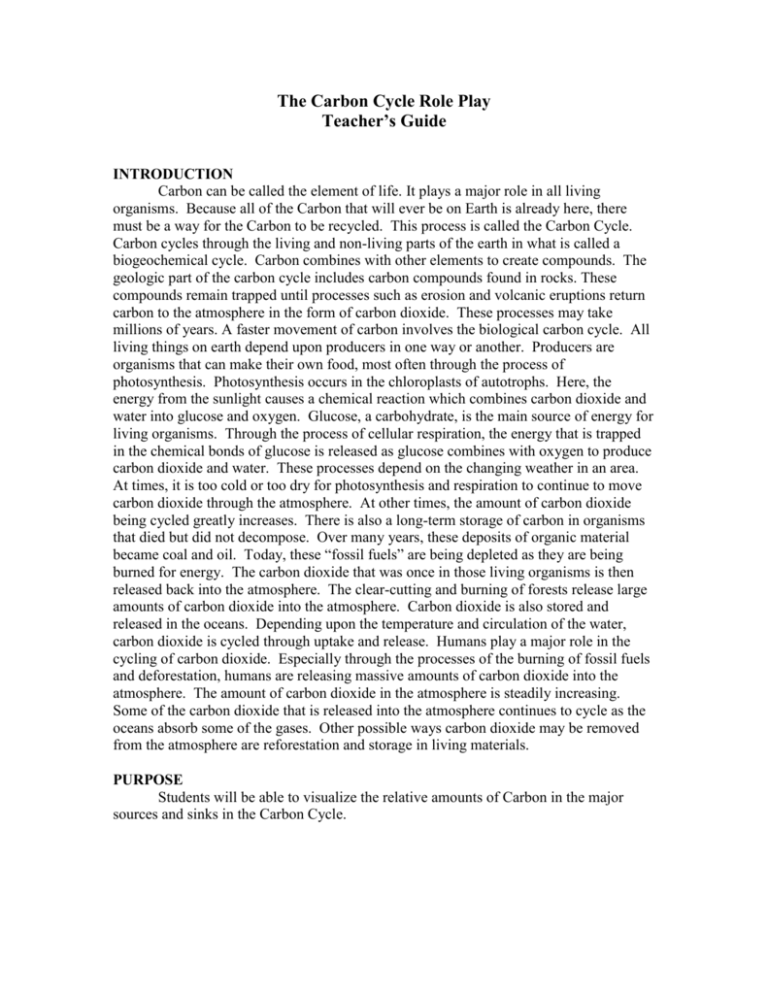
The Carbon Cycle Role Play Teacher’s Guide INTRODUCTION Carbon can be called the element of life. It plays a major role in all living organisms. Because all of the Carbon that will ever be on Earth is already here, there must be a way for the Carbon to be recycled. This process is called the Carbon Cycle. Carbon cycles through the living and non-living parts of the earth in what is called a biogeochemical cycle. Carbon combines with other elements to create compounds. The geologic part of the carbon cycle includes carbon compounds found in rocks. These compounds remain trapped until processes such as erosion and volcanic eruptions return carbon to the atmosphere in the form of carbon dioxide. These processes may take millions of years. A faster movement of carbon involves the biological carbon cycle. All living things on earth depend upon producers in one way or another. Producers are organisms that can make their own food, most often through the process of photosynthesis. Photosynthesis occurs in the chloroplasts of autotrophs. Here, the energy from the sunlight causes a chemical reaction which combines carbon dioxide and water into glucose and oxygen. Glucose, a carbohydrate, is the main source of energy for living organisms. Through the process of cellular respiration, the energy that is trapped in the chemical bonds of glucose is released as glucose combines with oxygen to produce carbon dioxide and water. These processes depend on the changing weather in an area. At times, it is too cold or too dry for photosynthesis and respiration to continue to move carbon dioxide through the atmosphere. At other times, the amount of carbon dioxide being cycled greatly increases. There is also a long-term storage of carbon in organisms that died but did not decompose. Over many years, these deposits of organic material became coal and oil. Today, these “fossil fuels” are being depleted as they are being burned for energy. The carbon dioxide that was once in those living organisms is then released back into the atmosphere. The clear-cutting and burning of forests release large amounts of carbon dioxide into the atmosphere. Carbon dioxide is also stored and released in the oceans. Depending upon the temperature and circulation of the water, carbon dioxide is cycled through uptake and release. Humans play a major role in the cycling of carbon dioxide. Especially through the processes of the burning of fossil fuels and deforestation, humans are releasing massive amounts of carbon dioxide into the atmosphere. The amount of carbon dioxide in the atmosphere is steadily increasing. Some of the carbon dioxide that is released into the atmosphere continues to cycle as the oceans absorb some of the gases. Other possible ways carbon dioxide may be removed from the atmosphere are reforestation and storage in living materials. PURPOSE Students will be able to visualize the relative amounts of Carbon in the major sources and sinks in the Carbon Cycle. AHSGE OBJECTIVE #14 Trace biogeochemical cycles through the environments including: water, carbon, oxygen and nitrogen. Demonstrate an understanding of the carbon cycle. Describe all events of the carbon cycle. SAFETY Students will be tempted to throw objects. MATERIALS 27 Black balls or pompoms Name Tags PROCEDURE Students should have a basic understanding of the events in the carbon cycle. Five students will play the role of carbon sinks: atmosphere, producers, soil, rock, and fossil fuels. The students will hold the following number of objects to represent the tons of carbon found in each carbon sink: Atmosphere—3 Producers—3 Soil—6 Rock—105,000 (represented by a sign not objects) Fossil Fuels—15 The students will begin role playing the movement of carbon through the biogeochemical cycle. Ask the following questions and instruct the students which way to pass the carbon: 1. Where do producers get the carbon dioxide for the process of photosynthesis? (the atmosphere) a. Represent this process by having the atmosphere pass one object to the producers 2. Consumers get carbon from producers by consuming the carbohydrates produced during photosynthesis. When an organism dies, where does the carbon go? (the soil) a. Represent this process by having the producer pass one object to the soil 3. There are organisms in the soil undergoing cellular respiration in which carbon dioxide is released. Where does the carbon compound go? (the atmosphere) a. Represent this process by having the soil pass one object to the atmosphere. 4. Represent a stable carbon cycle by having the students continue passing one object at a time from the atmosphere to producer to soil to atmosphere. 5. Rocks and Fossil Fuels did not participate because they are a part of the long-term carbon cycle. The carbon compounds in rocks are released during volcanic eruptions. The carbon compounds in fossil fuels are released during the combustion of these fuels. 6. Have two more students come up to participate. One student will be the fossil fuel consumer and the other will be deforestation. 7. What is something that consumes fossil fuels? (car, power plant, etc.) What happens to the carbon that was stored in the fossil fuels? (it’s released into the atmosphere) a. Represent this process by having the fossil fuel consumer take three objects from the fossil fuel deposits and pass them to the atmosphere. 8. What are some reasons for deforestation? (building neighborhoods, timber, forest fires, etc.) What process do these plants cease performing? (photosynthesis) a. Represent this process by having deforestation remove one object from the Producers and pass it to the atmosphere. 9. Have the students continue to pass the objects in this manner for a few rounds. This represents the carbon cycle with human influences. Who ends up with the most carbon? (the atmosphere) 10. Reforestation can have significant affects on the amount of carbon in the atmosphere. a. Represent this process by having another student become Reforestation. Continue the role play, but Reforestation takes two objects from the atmosphere each cycle. b. Continue the role play without the participation of Deforestation. 11. How does reforestation affect the amount of carbon in the atmosphere? Can reforestation alone be used to bring the amount of carbon in the atmosphere back to the original amount (3 objects)? (no) 12. What are other strategies that can be used to reduce the amount of carbon in the atmosphere or the emissions of new carbon into the atmosphere? OBSERVATION AND ANALYSIS 1. Draw the carbon cycle including the steps as represented in the role play. 2. What impact do human activities have on the carbon cycle? 3. What can you infer from the increased amounts of carbon in the atmosphere as it is related to climate change? 4. What are some possible changes humans can make to cut emissions? This activity is an adaptation of Please Pass the Carbon (Activity 4 from the Climate Change Back Pack, http://www.sciencecentercollaborative.org/backpack.php) and The Terrestrial Carbon Cycle: A Role-Play created by UNC-Chapel Hill’s Environmental Resource Program http://www.ie.unc.edu/erp/index.cfm Picture Sources http://www.aerospaceweb.org/question/atmosphere/earth/atmosphere.jpg http://ecoworldly.com/files/2009/07/searocket-plants_cakile_maritima.jpg http://www.blogcdn.com/www.greendaily.com/media/2008/03/soil-ammendment550.jpg http://upload.wikimedia.org/wikipedia/commons/7/72/DirkvdM_rocks.jpg http://www.mapsofworld.com/business/industries/coal-energy/world-coal-deposits.jpg http://static.howstuffworks.com/gif/co2-scrubbing-4.jpg http://mrhiggins.net/algebra2/wp-content/uploads/2008/06/smile.jpg http://blogs.tnr.com/tnr/blogs/environmentandenergy/amazon_deforestation.jpg Atmosphere Producers Soil Rock (105,000) Fossil Fuel Deposits Fossil Fuel Consumer Deforestation Reforestation

